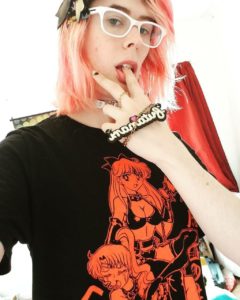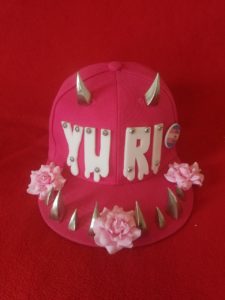Let’s talk about anime fashion that depicts queerness. Rather, let’s talk about anime fashion that evokes or depicts queerness while being worn by queer folks. This distinction’s importance is tantamount to the politicizing nature of the construct I’m going to discuss in this article; “Queer Anime Fashion.”
 Once a year for almost two decades Sakura-con, once Baka!-con, has blessed the state of Washington with a days long influx of anime fans, celebration, and artistry. Back in mid April, I was lucky enough to attend my first Sakura-Con as a volunteer in its Artists Alley. For those who are not convention fluent an Artists Alley is where talented fans can sign up for booth spaces to sell their anime-inspired wares. It’s an incredible spectacle of artistry and dedication and I’m humbled that I was given the opportunity to assist these lovely people. Also of note at Sakura-Con is the vendor’s hall. This houses large brands selling their official merchandise as well as independent brands one of which, AnimeTrashSwag, will be a major focus of this article.
Once a year for almost two decades Sakura-con, once Baka!-con, has blessed the state of Washington with a days long influx of anime fans, celebration, and artistry. Back in mid April, I was lucky enough to attend my first Sakura-Con as a volunteer in its Artists Alley. For those who are not convention fluent an Artists Alley is where talented fans can sign up for booth spaces to sell their anime-inspired wares. It’s an incredible spectacle of artistry and dedication and I’m humbled that I was given the opportunity to assist these lovely people. Also of note at Sakura-Con is the vendor’s hall. This houses large brands selling their official merchandise as well as independent brands one of which, AnimeTrashSwag, will be a major focus of this article.
The power anime fashion that depicts queerness wields has been consistently surprising to me during my experiences at SakuraCon. Queered anime at SakuraCon is both present and admired explicitly and openly. Cosplay of LGBTQ characters, fan art of characters in queer relationships printed on t-shirts, pins, and patches were everywhere. Of course much of this is fetishistic. Context is everything here; a lesbian buying an explicit shirt with two Sailor Scouts from Sailor Moon taking part in kink does not appear fetishistic to me or the sapphic queer folks in my immediate social circle. And in fashion appearances are everything. This is why I am defining Queer Anime Fashion as separate from anime fashion depicting queerness because it is the visible display of reclaiming and its inherent political nature that I am interested in.
A hot pink snap-back. Studded with metal spikes on the bill and two at the top to resemble horns. Three dainty pink flowers affixed around the horns to bring them into starker relief. Across the front four white plastic bold letters spell out “Y U R I.” They are affixed with screws and the bottoms stylized to look like bodily secretions, the white color chosen for its lack of subtlety. This is a hat made of contrasting elements but the whole is deeply harmonious. It is pointedly intentional. Girly, sharp, and sexual. Yuri is the genre name for lesbian content in anime and manga and can be translated as “lily,” a flower that is a symbol of purity. The trope being that a relationship between two girls could be nothing but sweet, kind, and innocent. The hat operates in multivalent states. It is both a pink hat and a hat that satirizes pink as a girly color and its relationship to cute and nice things. It is nice and it is ugly and it is both of these things.
So too does the hat problematize the ideal of female softness. I, like many queer femmes, love being soft but I have my spikes and metal screws and I love them as well for they are no less “me.” Flowers exist as a kind invitation, dripping with symbolism of gifting female attention. Spikes are a warning: do not touch. The hat acknowledges the complex nature of queer anime femininity. Sailor Moon is a great example of this. Gorgeous girls who kick evil’s ass, soft and hard without ever not being either. You can kill with a flower and invite with a spike.
The bold font of the letters recalls the boldness most often associated with corporate branding. The hat exists as a capitalist object, created to be sold for profit but it also satires its own existence. The advertisement-bold lettering that morphs into depiction of femme sexual secretions highlights the idea that sex sells but actual lesbian sex doesn’t. You can package up conventionally attractive cis women to the male masses of capitalism’s driving forces but the actual lived experience of two femmes in love is a low tier seller. The hat forefronts that “yes I am a capitalist object” and takes the knowledge of its subject matter’s status as repressed by patriarchal capitalism and dresses up in capitalist clothes in pantomime. It uses capitalism’s rules to sell maligned narratives. One of the two CEOs of Anime Trash Swag, the artists who sell the hat, has the phrase “gettin’ money like a white man” right in their Twitter bio. It’s hard to not be in on the joke.
Gaming economic power structures is sometimes a necessary “evil.” You can resist capitalism but you also have to function within it. So run with it, it is a machine that attempts to commodify everything it touches. If the large anime studios are going to package and sell lesbians, then so can we, the actual lesbians. My hat says Yuri but my visibly queer body refers to the un-packaged messy sapphic nature of a trans girl lesbian. I make men uncomfortable; I get stares. They want sweetness and innocence; schoolgirls bashfully kissing. I offer queer femininity; stubble and makeup; sweetness and rage; repression and painfully loud expression. Queer women are not for easy digestion even to each other. Show me the yuri anime where the femmes have to discuss the tricky nature of emotional labor. I want to make men uncomfortable, I want to remind them what we actually look like. This is the act of reclamation. This hat worn by cis dudes is not my hat. These are two separate objects. My hat is a loud attempt at reclaiming “girls love” by a girl who loves girls. Their hats are a fetishistic consumption of Othered sexual minorities. Their hat objectifies people, my hat deconstructs systems.
 I purchased a necklace from Anime Trash Swag as well. It is a chain necklace that reads “Futanari.” For the uninitiated futanari is a genre of hentai, anime porn, that mostly features femme characters with penises. Usually these are conventionally attractive women with large hips and breasts who are embarrassed by the presence of their penis.
I purchased a necklace from Anime Trash Swag as well. It is a chain necklace that reads “Futanari.” For the uninitiated futanari is a genre of hentai, anime porn, that mostly features femme characters with penises. Usually these are conventionally attractive women with large hips and breasts who are embarrassed by the presence of their penis.
I have a girlcock. I look like I have a girlcock. I’m sure many folks clock me as a trans woman. Whatever baggage comes with that is uninteresting to me here. What is of interest to me is to brand myself as Futanari. An outmoded word for hermaphrodite that stuck around with anime from its popularity in the ’90s. Here is the painful irony. I am not a beautiful futa anime girl. They are as gorgeous as the artist who drew them desired them to be. I hate heterosexual men for wanting me to be that way but I also want me to be that way. The necklace solves this paradox. It allows me to proclaim my sisterhood with these attractive fictional women, I am also a hot girl with a dick. While also popping the bubble of these fetishists by reminding them of the lived experiences of these femmes they often despise. You cannot consume our depiction and then work at our destruction. I will not allow it and every shitty boy who sees my necklace is denied this. This is why a “Futanari” necklace is a wholly different piece of fashion from a “Futanari” necklace worn by a trans femme who has a dick. The former is a call back to fetishitazaion culture in anime and the other is a woman trying to reclaim her own sexuality from the same groups who would potentially vote to remove her health care and access to public facilities, threaten her in public, and refuse to acknowledge her identity.
Here the message is to undermine the objectifying elements of anime and instead broadcast the wearer’s ownership of their varied identities through the cultural weight of anime fandom.
I have been inspired by my experiences at Sakura-Con to write about this concept and in future pieces I hope to further both my own understanding and spark discussion about Queer Anime Fashion. However now that I have opened Pandora’s wardrobe, I imagine writing about fashion in a broader spectrum. I have been playing the surprisingly good Love Nikki Dress-Up Queen and my head is full of ideas about what I can do to share my experience with it.
Lastly I would like to completely shill for Anime Trash Swag (@ANIMETRASHSWAG on twitter and instagram, animetrashswag.com). As well as @van___van and @hvyblk on instagram for keeping me looking queer and weeby.

